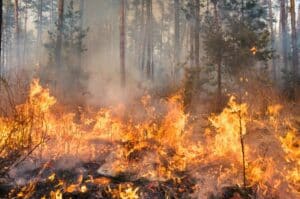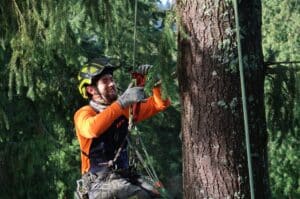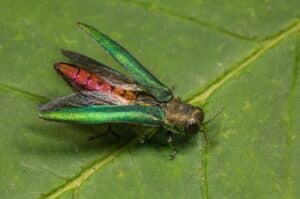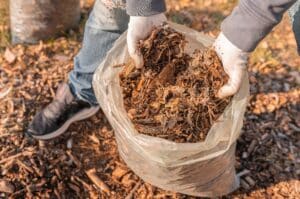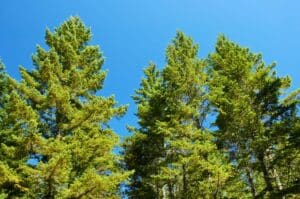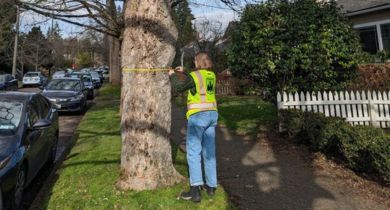My Tree is Leaning. Is It Dangerous?
A leaning tree in your yard may not just disrupt your landscape's aesthetics—it could be a safety risk. Learn how to assess the severity of the lean, identify the potential cause(s), and determine whether it’s a danger that warrants taking immediate action.
Seattle’s strong winds and varied terrain often lead to leaning trees. Unfortunately, a leaning tree in your yard may not just disrupt your landscape’s aesthetics—it could be a safety risk. If you’ve noticed your tree leaning, it’s important to understand why it’s happening and how to address it. This guide will help you assess the severity of the lean, identify the potential cause(s), and determine whether the lean warrants taking immediate action.
Since municipal tree codes in the greater Seattle area can limit removal except in instances of hazardous trees, it becomes crucial to understand what constitutes a dangerous leaning tree. Our guide aims to demystify this for you while underscoring the value of professional care in maintaining tree health and safety.
Key Takeaways
- Understanding why trees lean, including environmental and genetic factors, is crucial for identifying potential risks.
- Indicators like exposed roots, soil heaving, and unbalanced crowns help differentiate between natural and hazardous leans.
- If a tree has a severe lean or appears unstable, it’s essential to seek a certified arborist’s assessment and solutions like pruning or removal.
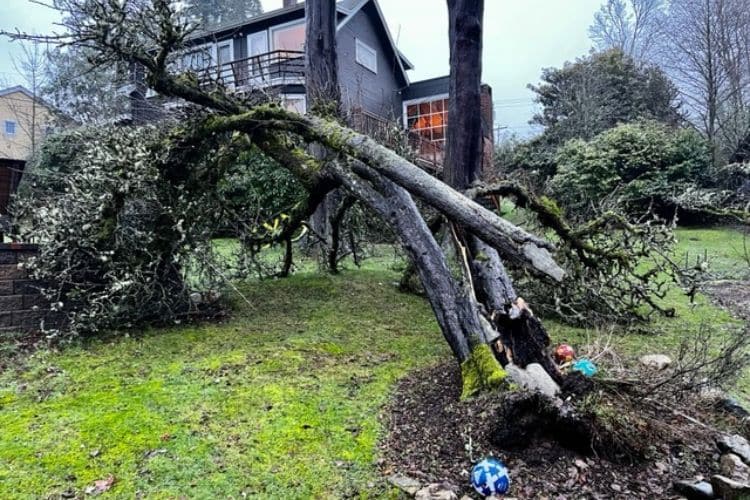
Leaning Trees in Seattle: What Causes Them to Lean?
In Seattle’s dynamic climate, trees lean for various reasons, from persistent wind patterns to uneven sunlight exposure. While some leans are part of a tree’s natural adaptation to their environment, others signal danger. Understanding the factors contributing to this phenomenon is key to discerning between a natural and a potentially hazardous lean.
Persistent Wind Patterns
Trees may develop a lean in response to ongoing pressure in areas with a consistent wind direction. This is known as ‘wind throw,’ where the tree grows at an angle to better withstand the prevailing winds. Such leans are often gradual and part of the tree’s natural environmental adaptation.
Soil Conditions
The type and stability of the soil play a crucial role in a tree’s growth orientation. Soft, wet, or eroded soils can cause trees to lean as their root systems struggle for anchorage. In contrast, trees in rocky or compacted soils may lean as they grow around these harder surfaces.
Uneven Sunlight Exposure
Trees inherently grow towards light, a phenomenon known as phototropism. Trees might lean towards the available light source in densely forested areas or urban settings where light is not evenly distributed. This lean is generally slow and progressive as the tree seeks optimal light conditions for photosynthesis.
Competition for Resources
Trees compete for sunlight, water, and nutrients in forested areas. A tree may develop a lean to avoid the shade of larger trees or to access unobstructed light and rainwater. This competition can drive a tree to adapt its growth direction over time.
Genetic Factors
Some tree species are naturally inclined to grow at an angle due to their genetic makeup. This characteristic lean is often observed in species adapted to specific environmental conditions.
Damage or Disease
Trees may lean due to damage to their root systems or trunks. Diseases that weaken a tree’s structural integrity, such as root rot or trunk decay, can also lead to leaning. This type of lean can be sudden and is more likely to pose a risk.
Human Activity
Construction, landscaping, and other human activities can impact a tree’s growth. Soil compaction, changes in soil grade, or root system disturbances due to construction are common causes of leaning in urban settings.
While a leaning tree can be a natural and harmless feature, it’s essential to look at the underlying causes. Regular observation and understanding of the context of a tree’s lean can help determine whether it poses any risk.
If you’re uncertain about the risk posed by a leaning tree, it’s always best to consult a professional, such as the ISA Certified Arborists at Seattle Tree Care. Our experts closely examine each leaning tree, considering factors like root exposure and crown balance, to differentiate between a charming quirk of nature and a potential threat, and provide tailored solutions that adhere to Seattle’s unique environmental context and municipal tree codes.
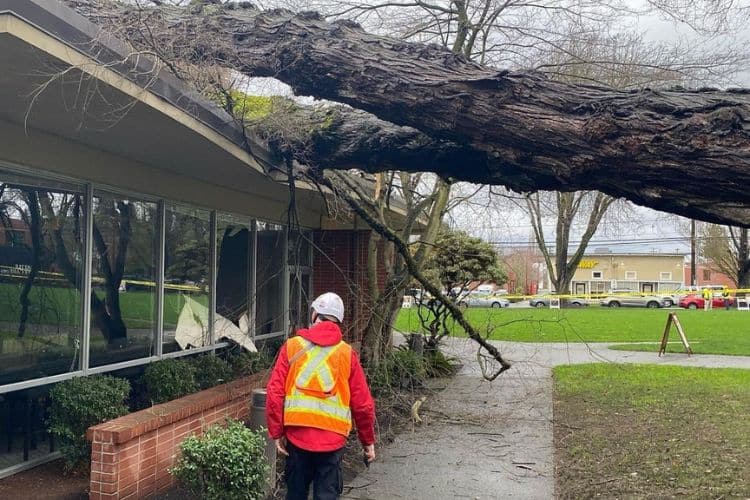
How Much is Too Much? Identifying a Dangerous Tree Lean
Determining whether a tree’s lean poses a risk requires careful observation of several key indicators. The signs described below can help differentiate between a natural, harmless lean and one that might require intervention.
Exposed Roots: Signs of Instability
Roots visibly protruding above the soil surface can indicate the tree is losing its anchorage. Look for roots breaking through the ground, especially on the side opposite the lean. This can be a sign that the tree is gradually being uprooted.
Soil Heaving: A Warning of Uprooting
Soil heaving occurs when the soil is pushed up or bulges on the side of the tree opposite the lean. This bulging can be a clear indication that the tree’s root system is struggling to hold its ground, potentially leading to uprooting.
Visible Signs of Root Rot: A Structural Hazard
Fungal growth, a spongy feeling around the base, or a foul smell can signal root rot. Root rot weakens the tree’s foundation, making it more susceptible to falling, especially if it’s leaning.
Unbalanced Crown: The Weight Factor
An unevenly heavy or dense crown can put additional stress on the tree, exacerbating the lean. Look for branches that are overgrown or clustered on one side. This uneven weight distribution can lead to a hazardous lean.
Cracks or Cavities in the Trunk
Vertical cracks or cavities in the trunk, especially on the side of the lean, can indicate internal decay or weakness. These structural damages can compromise the tree’s stability and increase the risk of it falling.
Sudden Leaning
A lean that becomes noticeably more pronounced over a short period is a red flag. We often see trees start to lean after significant storms, particularly when the soil becomes highly saturated. Rapid changes in the angle or direction of the lean suggest that the tree is losing its structural integrity.
Nearby Construction Impact
Recent construction or landscaping work near the tree can affect its stability. Disturbance to the surrounding soil or root system, such as cutting major tree roots to install irrigation, paving over large parts of the root zone, or adding a significant amount of soil around the tree, can lead to a dangerous lean.
History of Falling Branches
If the tree has a history of dropping branches, particularly on the side it’s leaning towards, it could indicate an underlying weakness.
When a leaning tree raises concerns, call in the professionals to evaluate it sooner rather than later. The Certified Arborists at Seattle Tree Care will assess, prune, or safely remove trees in line with Seattle’s commitment to sustainability. You can trust in our expertise to maintain the delicate balance between natural beauty and urban safety.
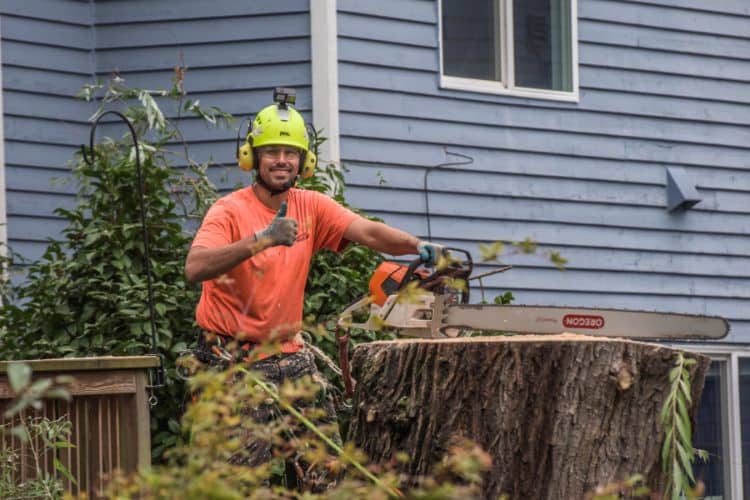
FAQs About Leaning Trees
Q. Are certain tree species more prone to leaning?
A. Yes, certain tree species are more prone to developing a lean due to factors like genetic growth habits, root structure, and environmental adaptability. Trees with shallow root systems, such as willows, poplars, and some maples, often lean in unstable soil conditions. Fast-growing species may also lean more easily under environmental stress. It’s crucial to select the right tree species for specific locations.
Q. Can a tree recover from leaning by itself?
A. tree can sometimes naturally recover from a mild lean, particularly if young and healthy. The tree’s ability to self-correct depends on factors like the degree of lean, age, species, health, and environmental conditions. However, significant leans often require intervention, especially in older or larger trees.
Q. Are there any DIY solutions for minor tree leans?
For minor tree leans, DIY solutions include staking or guying the tree for support, adjusting the soil around the base, ensuring proper watering and mulching, and light pruning to balance the crown. These methods are most effective for young or small trees. However, we recommend you consult a professional arborist to safely and appropriately manage significant leans or larger trees.
Q. Do I need a permit to remove my leaning tree in Seattle?
In Seattle, you may need a permit to remove a tree depending on its location, size, and status. Permits are generally required for street trees, significant trees (often defined by size), and exceptional trees noted for their species, size, or historical value. However, a permit might not be necessary for hazardous trees posing immediate danger. Always check with Seattle’s local regulations or consult a certified arborist to ensure compliance with the city’s tree removal laws.
Q. What should I do if my neighbor’s tree is leaning towards my property?
A. If your neighbor’s tree is leaning towards your property, discuss the issue with them. Document the tree’s condition with photos and consider getting an assessment from a certified arborist. Familiarize yourself with local tree laws, as these can impact your rights regarding encroaching trees. You may need legal advice if the issue isn’t resolved and the tree poses a risk. Always approach the situation diplomatically to maintain good neighborly relationships.
Lean on Seattle Tree Care
Understanding the causes and risks associated with leaning trees is vital for maintaining the safety and health of your landscape. Don’t wait for the situation to worsen if you observe signs of a dangerous lean in your trees. Act now to protect your property and loved ones.
Contact Seattle Tree Care, the first locally owned, accredited tree service in Seattle, and let our team of certified arborists provide the expert care your trees need. We’re not just treating symptoms; we’re providing a holistic approach to tree health, preserving Seattle’s lush canopy for generations to come.
Remember, proactive tree care is not just a choice—it’s a responsibility that helps keep your home and community safe. Reach out to Seattle Tree Care today at 206-789-0534 for an expert assessment of any leaning trees on your property.
Recent Articles
Looking for More?
We've got you covered with tips, resources, updates, how-to's, and other helpful information about trees and landscapes in Seattle, Puget Sound, and King County, WA. Join the thousands of smart local residents who get the monthly newsletter from Seattle Tree Care for helpful information you won't want to miss!
There's no spam - we promise! We are committed to keeping your e-mail address confidential. We do not sell, rent, or lease our contact data or lists to third parties.


